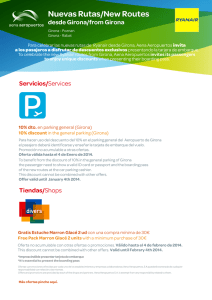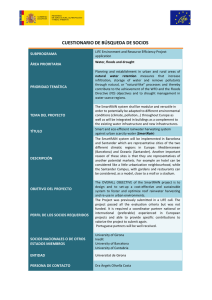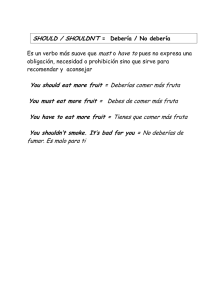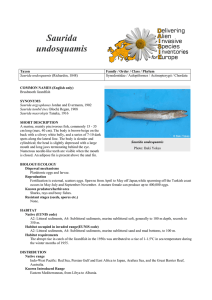(Wiedemann) under Natural Winter Conditions in North East Spain
Anuncio
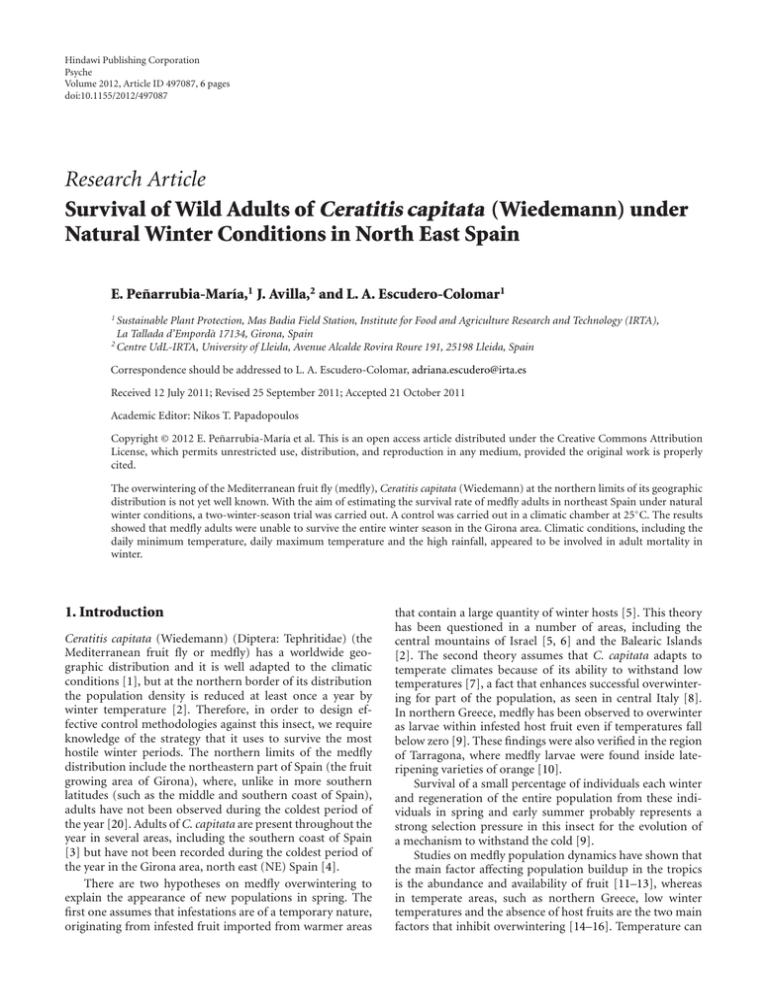
Hindawi Publishing Corporation Psyche Volume 2012, Article ID 497087, 6 pages doi:10.1155/2012/497087 Research Article Survival of Wild Adults of Ceratitis capitata (Wiedemann) under Natural Winter Conditions in North East Spain E. Peñarrubia-Marı́a,1 J. Avilla,2 and L. A. Escudero-Colomar1 1 Sustainable Plant Protection, Mas Badia Field Station, Institute for Food and Agriculture Research and Technology (IRTA), La Tallada d’Empordà 17134, Girona, Spain 2 Centre UdL-IRTA, University of Lleida, Avenue Alcalde Rovira Roure 191, 25198 Lleida, Spain Correspondence should be addressed to L. A. Escudero-Colomar, [email protected] Received 12 July 2011; Revised 25 September 2011; Accepted 21 October 2011 Academic Editor: Nikos T. Papadopoulos Copyright © 2012 E. Peñarrubia-Marı́a et al. This is an open access article distributed under the Creative Commons Attribution License, which permits unrestricted use, distribution, and reproduction in any medium, provided the original work is properly cited. The overwintering of the Mediterranean fruit fly (medfly), Ceratitis capitata (Wiedemann) at the northern limits of its geographic distribution is not yet well known. With the aim of estimating the survival rate of medfly adults in northeast Spain under natural winter conditions, a two-winter-season trial was carried out. A control was carried out in a climatic chamber at 25◦ C. The results showed that medfly adults were unable to survive the entire winter season in the Girona area. Climatic conditions, including the daily minimum temperature, daily maximum temperature and the high rainfall, appeared to be involved in adult mortality in winter. 1. Introduction Ceratitis capitata (Wiedemann) (Diptera: Tephritidae) (the Mediterranean fruit fly or medfly) has a worldwide geographic distribution and it is well adapted to the climatic conditions [1], but at the northern border of its distribution the population density is reduced at least once a year by winter temperature [2]. Therefore, in order to design effective control methodologies against this insect, we require knowledge of the strategy that it uses to survive the most hostile winter periods. The northern limits of the medfly distribution include the northeastern part of Spain (the fruit growing area of Girona), where, unlike in more southern latitudes (such as the middle and southern coast of Spain), adults have not been observed during the coldest period of the year [20]. Adults of C. capitata are present throughout the year in several areas, including the southern coast of Spain [3] but have not been recorded during the coldest period of the year in the Girona area, north east (NE) Spain [4]. There are two hypotheses on medfly overwintering to explain the appearance of new populations in spring. The first one assumes that infestations are of a temporary nature, originating from infested fruit imported from warmer areas that contain a large quantity of winter hosts [5]. This theory has been questioned in a number of areas, including the central mountains of Israel [5, 6] and the Balearic Islands [2]. The second theory assumes that C. capitata adapts to temperate climates because of its ability to withstand low temperatures [7], a fact that enhances successful overwintering for part of the population, as seen in central Italy [8]. In northern Greece, medfly has been observed to overwinter as larvae within infested host fruit even if temperatures fall below zero [9]. These findings were also verified in the region of Tarragona, where medfly larvae were found inside lateripening varieties of orange [10]. Survival of a small percentage of individuals each winter and regeneration of the entire population from these individuals in spring and early summer probably represents a strong selection pressure in this insect for the evolution of a mechanism to withstand the cold [9]. Studies on medfly population dynamics have shown that the main factor affecting population buildup in the tropics is the abundance and availability of fruit [11–13], whereas in temperate areas, such as northern Greece, low winter temperatures and the absence of host fruits are the two main factors that inhibit overwintering [14–16]. Temperature can 2 also affect the appearance of the population after the winter period, retarding or advancing adult presence, as seen in Girona [4]. Although medfly distribution appears to be ultimately restricted by the severity of the winter, the existence of a variety of microclimates in a particular area implies that other climatic factors may limit or at least regulate the population dynamics of the species [17]. Survival in insects depends on both temperature and duration of exposure [18], and the duration of low temperatures could be used to test the medfly’s tolerance to cold [19]. Therefore, the combination of factors such as dry and cold stress [17] and duration of low temperatures could explain the low incidence of the pest in a particular location. Recent studies performed in Girona support the hypothesis of an overwintering population in this area [4], but the conditions of medfly overwintering are still unknown. Therefore, the aim of this study was to estimate the survival rate of medfly adults in the Girona fruit area, NE Spain under natural winter conditions over a period of two winter seasons and to test the hypothesis that adult medflies survive winter conditions in this area. 2. Material and Methods The trial was performed over two consecutive winters: from mid-December 2008 to mid-January 2009 and from midNovember 2009 to late December 2009. It was performed on a 962 m2 north-facing commercial plot of “Golden Delicious” apples, enclosed by a wood structure with walls and a roof made of plastic mesh. The plot was divided into three sealed compartments with the same dimensions, each with its own access door. Climatic conditions in the three compartments, including temperature and relative humidity, sometimes differed slightly. The control treatment was arranged in a chamber maintained at 25◦ C ± 1◦ C, 50–80% RH with a photoperiod of 14 h light and 10 h darkness in order to determine the viability and longevity of the population used in the field. In 2008, 236 five-to-seven-day-old second-generation (F2) adults originally from an autochthonous population reared under controlled conditions in Girona were used, and in the following year 212 six-day-old wild flies were used, with the aim of avoiding any influence from laboratory rearing conditions. Individuals were placed in cages (61 by 61 by 61 cm) provided with an ad libitum diet composed of 1 : 4 : 5 parts of hydrolysed protein (Biokar Diagnostics, Beauvais, France), sugar, and water. In the second year, a mesh was placed on the base of the cages in order to prevent the flies from sinking into rain water. Each cage was placed on two wooden supports in order to avoid direct contact with the ground. They were also fixed to the soil surface with two 1.5 cm diameter iron pegs to avoid movement caused by the wind. Three cages (replicates) each containing 45–60 individuals were established on 16 December 2008 and 16 November 2009. The cages were evenly distributed among the compartments of the plot and were maintained under natural Psyche winter conditions. In each year a similar control cage was maintained in an environmental chamber at 25◦ C ± 1◦ C. Once the cages had been installed, individual mortality was recorded on a daily basis until the death of the last individual. During both experimental periods, meteorological data were recorded outside the observation orchard at a weather station located 700 m from the survey plot [20]. Moreover, inside each compartment of the observations plot, as well as in the chamber, temperature and relative humidity were recorded hourly using data loggers hung 1.60 m above ground level (Hobo Pro V2-ext. Temp/RH, Onset Company). The survival analysis was carried out using the KaplanMeier estimates of survival and standard error followed by the log-rank test for pairwise comparisons (P = 0.05). Hence, the three replicates combined and compared against control. This statistical analysis was carried out using the SPSS v.15 software. The relationship among the following factors was studied: year of the study, age of adults, daily minimum temperature, daily maximum temperature, daily average temperature, and daily rainfall, using the General Linear Model (Proc GLM) procedure of the Statistical Analysis System (SAS Institute Inc., Cary, NC, USA) to determine significant differences at a level of P < 0.05. 3. Results The results of these observations suggest that adults of C. capitata are unable to survive throughout the winter season in the Girona fruit-growing area. Adults subjected to external conditions remained immobile inside field cages, resting on the mesh walls or in the iron-clad corners, but adults inside cages in the environmental chamber were more active. Under natural winter conditions in Girona, adult flies survived an average of 8.43 to 9.88 days in the first study period (starting in mid-December) and 28.45 to 30.24 days in the second (starting in mid-November), but under chamber conditions they survived an average of 15.5 days and 12.87 days, respectively (Table 1). The maximum survival period under natural conditions was 11 days in the first winter and 35 days in the second; under chamber conditions, the figures were 29 and 38 days, respectively. Graphs of cumulative survival rates over the study period are given in Figure 1. The log-rank test indicated differences in survival rates between field exposed and laboratory-held control individuals (χ 2 = 41.02, P < 0.5). Similar results obtained when control was compared against each replicate within the same year. The analysis comparing the survival in the control versus the survival in each replicate provided information related to the possible sources of variability between replicates that are difficult to measure separately in each replicate, such as the wind, normally strong in the study area and usually flowing in NE-SE direction. Due to the orientation of the orchard involved in the study (N-S), each of the replicates could have been differently exposed to it. The temperature and relative humidity recorded in each cage using data loggers were very similar to those recorded Psyche 3 Table 1: Number of individuals, average survival rates, and maximum survival for Mediterranean fruit fly adults exposed in field conditions in December and November 2008 and 2009, respectively. Year 2008-2009 No. of adults Survival average ± SE (days) 1 2 3 Control 1 2 3 Control 60 60 60 56 54 45 55 58 8.62 ± 0.47 9.88 ± 0.33 8.43 ± 0.44 15.5 ± 1.02 30.24 ± 0.85 29.04 ± 0.78 28.45 ± 1.11 12.87 ± 1.30 1 1 0.8 0.8 Cumulative survival (lx) Cumulative survival (lx) 2009 Replicate 0.6 0.4 0.6 0.4 0.2 0.2 0 0 15/12/08 22/12/08 29/12/08 5/01/09 12/01/09 Maximum life span for the longest lived individual 18 16 18 34 41 38 41 43 16/11/09 23/11/09 30/11/09 7/12/09 14/12/09 21/12/09 Dates Dates (a) (b) Figure 1: Cumulative survival rates of adult medflies exposed to field conditions on (a) December 16, 2008, and (b) November 16, 2009, and respective controls maintained at 25◦ C in laboratory conditions (dotted line, control; solid line, average for three replicates). at the nearby meteorological station, with maximum differences of ±1◦ C. The absolute maximum temperature was 18.8◦ C in the first year and 22.3◦ C in the second (Figure 2). The absolute minimum temperature was −2◦ C in the first year and −8.1◦ C in the second. The average temperature recorded inside the plot was 6.8◦ C in the first year and 8.3◦ C in the second. Relative humidity in the field cage was 47.54% to 100% in 2008 and 40.38% to 62.49% in 2009. Accumulated rainfall in the first year was 67.2 mm, with a maximum daily rainfall of 54.6 mm recorded on 26 December 2008. In the second year, these figures were 7.6 and 2.6 mm, respectively. In the second year of the study, one day after the absolute minimum temperature (−8.1◦ C) was recorded, 20.4% and 21.8% of the remaining living individuals from replicates 1 and 3 died, respectively. In the first year, between 16 November and the death of the last individual, the maximum number of cold hours below 9◦ C tolerated by adults was 173 hours, while in the second year, between 16 October and the end of the trial, this value was 464 hours. The GLM analysis showed a good fit of the model (R2 = 0.6983) and evidenced significant differences in the following factors: rainfall (F = 287.26, df = 1, P < 0.0001), daily minimum temperature (F = 9.27, df = 1, P = 0.0026), and daily maximum temperature (F = 11.20, df = 1, P = 0.001). The factors year of the study (F = 0.3, df = 1, P = 0.5870), age of adults (F = 0.14, df = 1, P = 0.7117), and daily average temperature (F = 2.63, df = 1, P = 0.1067) were not significant. 4. Discussion The results showed that medfly adults were unable to survive the entire coldest period of the Girona fruit-growing area. Although adults withstand a high number of cold hours by reducing their movement and keeping still, all of them died Psyche Dates (2008) (a) 20 19/12 16/12 13/12 10/12 7/12 4/12 1/12 10 Precipitation (mm) 30 28/11 0 40 25/11 27/12 26/12 25/12 24/12 23/12 22/12 21/12 20/12 19/12 18/12 10 50 22/11 20 60 19/11 30 30 25 20 15 10 5 0 −15 −10 −5 16/11 40 Temperature (◦ C) 50 Precipitation (mm) 60 17/12 30 25 20 15 10 5 0 −15 −10 −5 16/12 Temperature (◦ C) 4 0 Dates (2009) (b) Figure 2: Temperature and rainfall recorded within the observation plot and temperature in the control under chamber conditions (line with squares for temperature in the control; line with triangles for daily maximum temperature; line with circles for daily average temperature; line with rhombus for daily minimum temperature; dotted line for rainfall). after a strong freeze temperature (−8.1◦ C). It was observed that in semifield conditions the age reached by adults was higher than that of the control. The main factors affecting survival of adult medfly in natural winter conditions of Girona were minimum temperature, maximum temperature, and rainfall. Taking into account these results, the hypothesis that adult medfly may survive the natural winter conditions in the Girona fruit-growing area must be rejected. Medfly adults are unable to survive low winter temperatures in some Mediterranean areas, including Greece [9]. This was corroborated in the present overwintering study with adults from a population native to Girona. Adults survived winter conditions in this area from mid-November to late December. The insect’s resistance to cold is affected by its microhabitat, which determines the availability of moisture, the developmental temperature, and parameters such as humidity and desiccation tolerance [21]. Other biological factors involved are age, body size during adult development, and feeding. In our study, cold temperature led to a reduction in medfly movements until they kept completely still, at which point they surely did not feed; because they were provided with food ad libitum, we may assume that when they kept still they had enough energy reserves to withstand extreme temperatures. However, it was demonstrated that this process consumed a great amount of energy and that survival is subsequently compromised. On the other hand, Nyamukondiwa and Terblanche [22] showed that the minimum critical thermal limit (Ctmin ) decreases with age up to 14 days old, after which older flies have less tolerance to low temperatures; these authors also found no interaction between age and feeding in C. capitata. During cold and temperate winters, most species are inactive, leading to a seasonal state of quiescence, dormancy, or even diapause that varies with species and circumstances [21, 23]. It has been shown that, at lower latitudes in temperate regions, populations of certain tephritid species (e.g., Eurosta solidaginis (Fitch)) are less cold tolerant than those from higher latitudes [18]. Nevertheless, in some of the southern Mediterranean areas, a small number of medfly adults might be active during winter [15, 24]. In Crete adults survived the whole winter with minimum temperatures between 1◦ C and 4.5◦ C [25]. In the present study carried out in Girona, all individuals died during the winter. The temperature threshold for population growth is 12◦ C to 35◦ C, [17] and maximum temperatures in both years were always below the upper limit. However, minimum temperatures in the study periods sometimes fell below the lower threshold. There is high variability in the severity of the minimum temperature and the duration of exposure to low temperatures in the temperate zone [19]. Similar results to those found in the present study were recorded using the fruit fly Dacus tryoni at an overwintering site, where mortality was related to the minimum temperatures and mortality rate increased when subzero temperatures occurred [26]. The Ctmin for medfly is the temperature at which each individual insect loses coordinated muscle function and consequently the ability to respond to mild stimuli [22]. Adults exposed to this threshold recovered, so it was not immediately lethal. Depending on the age of the flies, Ctmin was 5.4◦ C to 6.6◦ C [22]. Taking into account these thresholds and the minimum temperatures recorded in Girona during the two study periods (−2◦ C and −8.2◦ C), it is possible that the study population lost coordinated muscle function, in which case they would have suffered a rapid demise. The effect of rainfall on the medfly population has been related to a decrease in adult captures on rainy days and an increase a few days later, because flies are generally inactive during periods of moderate to heavy rainfall [27, 28]. In the current trial, the mortality of adults was observed to be affected by rainfall. In the first year, rain fell for only a few hours, but this had a negative effect on adult survival. The relationship between the accumulated number of cold hours below 9◦ C and the survival of adults in the first period was also influenced by the high rainfall of 26 December 2008. Therefore, flies in the second year endured more than twice as many cold hours as those in the first year. Despite the results achieved in the two years of observation, there is a stable population in NE Spain. In the entire Girona fruit-growing area, the first adult medfly captured in Psyche the fruit season, using a wide monitoring network (one per orchard) installed from April to January, coincides year by year (mid-June to early July), as does the only population peak (late September to early October) [4]. In some microclimates of the region, medfly larvae may survive inside apples, the only fruit species available for overwintering in the area, as suggested by other authors [9]. It is clear from studies carried out in the area that the previous winter determines the level of the population in the following season. In years with a mild winter, after the capture of the first medfly in the season, the population developed fast and could reach high levels in the peak captures. On the other hand, after cold winters, even if the first medfly is captured on the same date, the population increases slowly, peaking as usual but never reaching the same level as in years following a mild winter [4]. An interesting fact is that, though temperature limits development, it does not necessarily limit the geographic distribution of this species [22]. This could explain why the medfly occurs in southern France, where it is frequently detected [29]. Some studies have developed models for the potential distribution of medfly, and in all of them the Girona area was included [17, 30]. One of the key points to elucidate is the threshold for classifying a winter as mild or cold, from the point of view of the medfly biology of the Girona population. How many cold hours below its Ctmin can the Girona medfly population withstand in order to have enough surviving individuals to quickly develop a new population in the following fruit season? At present we have no answers to this question, and a greater effort must be made to elucidate it. The implications of this knowledge are great, because it would allow us to forecast the development of the population, offering a great advantage for protecting fruit against this pest. 5. Conclusions Medfly adults were unable to survive the entire winter season in the Girona fruit-growing area in both years studied. Climatic conditions, including low minimum temperatures, maximum temperature, and high rainfall, were responsible for adult mortality in winter. This study makes a contribution to knowledge of the biology of medfly at the northern border of its distribution area, and, jointly with previous findings on the population dynamics of medfly in Girona, it provides a framework for future studies that may answer some of the remaining questions on the biology of the Girona population. Acknowledgments The present study was supported by the Instituto Nacional de Investigación y Tecnologı́a Agraria y Alimentaria under Research Project RTA2006-00092-00-00. The authors thank the Serveis Tècnics de Recerca of the University of Girona and Professor Joan Bonany for their statistical support. 5 References [1] J. R. Carey, “Host-specific demographic studies of the Mediterranean fruit fly Ceratitis capitata,” Ecological Entomology, vol. 9, no. 3, pp. 261–270, 1984. [2] M. A. Miranda, R. Alonso, and A. Alemany, “Field evaluation of Medfly (Dipt., Tephritidae) female attractants in a Mediterranean agrosystem (Balearic Islands, Spain),” Journal of Applied Entomology, vol. 125, no. 6, pp. 333–339, 2001. [3] P. Fimiani, “Mediterranean region,” in Fruit Flies: Their Biology, Natural Enemies and Control, World Crop Pests, pp. 39–50, 1989. [4] L. A. Escudero-Colomar, M. Vilajeliu, and L. Batllori, “Seasonality in the occurrence of the Mediterranean fruit fly [Ceratitis capitata (Wied.)] in the north-east of Spain,” Journal of Applied Entomology, vol. 132, no. 9-10, pp. 714–721, 2008. [5] N. Israely, U. Ritte, and S. D. Oman, “Inability of Ceratitis capitata (Diptera: Tephritidae) to overwinter in the Judean hills,” Journal of Economic Entomology, vol. 97, no. 1, pp. 33– 42, 2004. [6] N. Israely, Y. Ziv, and S. D. Oman, “Spatiotemporal distribution patterns of Mediterranean fruit fly (Diptera: Tephritidae) in the central region of Israel,” Annals of the Entomological Society of America, vol. 98, no. 1, pp. 77–84, 2005. [7] J. R. Carey, “Establishment of the Mediterranean fruit fly in California,” Science, vol. 253, no. 5026, pp. 1369–1373, 1991. [8] A. Sciarretta, D. Cesare, R. De Salvador, M. R. Tabilio, and P. Trematerra, “Spatio-temporal distribution of Ceratitis capitata trap catches in an agricultural landscape. Pheromones and other Semiochemicals,” IOBC/WPRS Bulletins, vol. 41, pp. 123–129, 2009. [9] N. T. Papadopoulos, J. R. Carey, B. I. Katsoyannos, and N. A. Kouloussis, “Overwintering of the Mediterranean fruit fly (Diptera: Tephritidae) in Northern Greece,” Annals of the Entomological Society of America, vol. 89, no. 4, pp. 526–534, 1996. [10] M. T. Martı́nez-Ferrer, J. M. Campos, and J. M. Fibla, “Population dynamics of Ceratitis capitata on citrus in northeast Spain: the influence of adjacent host fruit trees,” Bulletin OILB/SROP, vol. 29, pp. 77–84, 2006. [11] M. A. Bateman, “The ecology of fruit flies,” Annual Review of Entomology, vol. 17, pp. 493–518, 1972. [12] E. J. Harris and C. Y. Lee, “Development of Ceratitis capitata (Diptera: Tephritidae) in coffee in wet and dry habitats,” Environmental Entomology, vol. 18, pp. 1042–1049, 1989. [13] M. Niklaus-Ruiz Borge and T. Basedow, “A survey on the occurrence and flight periods of fruit fly species (diptera: Tephritidae) in a fruit growing area in southwest Nicaragua, 1994/95,” Bulletin of Entomological Research, vol. 87, no. 4, pp. 405–412, 1997. [14] N. Israely, B. Yuval, U. Kitron, and D. Nestel, “Population fluctuations of adult Mediterranean fruit flies (Diptera: Tephritidae) in a Mediterranean heterogeneous agricultural region,” Environmental Entomology, vol. 26, no. 6, pp. 1263– 1269, 1997. [15] N. T. Papadopoulos, B. I. Katsoyannos, J. R. Carey, and N. A. Kouloussis, “Seasonal and Annual Occurrence of the Mediterranean Fruit Fly (Diptera: Tephritidae) in Northern Greece,” Annals of the Entomological Society of America, vol. 94, no. 1, pp. 41–50, 2001. [16] N. T. Papadopoulos, B. I. Katsoyannos, N. A. Kouloussis, J. Hendrichs, J. R. Carey, and R. R. Heath, “Early detection and population monitoring of Ceratitis capitata (Diptera: Tephritidae) in a mixed-fruit orchard in northern Greece,” 6 [17] [18] [19] [20] [21] [22] [23] [24] [25] [26] [27] [28] [29] [30] Psyche Journal of Economic Entomology, vol. 94, no. 4, pp. 971–978, 2001. M. T. Vera, R. Rodriguez, D. F. Segura, J. L. Cladera, and R. W. Sutherst, “Potential geographical distribution of the Mediterranean fruit fly, Ceratitis capitata (Diptera: Tephritidae), with emphasis on Argentina and Australia,” Environmental Entomology, vol. 31, no. 6, pp. 1009–1022, 2002. D. L. Denlinger and R. E. Lee, “Physiology of cold sensitivity,” in Temperature Sensitivity in Insects and Application in Integrated Pest Management, pp. 55–95, 1998. W. J. Turnock and P. G. Fields, “Winter climates and coldhardiness in terrestrial insects,” European Journal of Entomology, vol. 102, no. 4, pp. 561–576, 2005. “DAR Agrometeorologia,” http://ruralcat.net. H. V. Danks, “Insect adaptations to cold and changing environments,” Canadian Entomologist, vol. 138, no. 1, pp. 1–23, 2006. C. Nyamukondiwa and J. S. Terblanche, “Thermal tolerance in adult Mediterranean and Natal fruit flies (Ceratitis capitata and Ceratitis rosa): effects of age, gender and feeding status,” Journal of Thermal Biology, vol. 34, no. 8, pp. 406–414, 2009. A. Meats, “Acclimation, activity levels and survival,” in Fruit Flies, Their Biology, Natural Enemies and Control, World Crop Pests, pp. 231–239, 1989. M. T. Martı́nez-Ferrer, A. Alonso, J. M. Campos, J. M. Fibla, and F. Garcia-Marı́, “Dinámica poblacional de la mosca de la fruta Ceratitis capitata en tres zonas citrı́colas mediterráneas,” Levante Agrı́cola , vol. 385, pp. 1–7, 2007. P. G. Mavrikakis, A. P. Economopoulos, and J. R. Carey, “Continuous winter reproduction and growth of the Mediterranean fruit fly (Diptera : Tephritidae) in Heraklion, Crete, southern Greece,” Environmental Entomology , vol. 29, pp. 1180–1187, 2000. B. S. Fletcher, “The overwintering survival of adults of the Queensland Fruit Fly, Dacus Tryoni, under natural conditions,” Australian Journal of Zoology , vol. 27, pp. 403–411, 1979. E. F. Appiah, K. Afreh-Nuamah, and D. Obeng-Ofori, “Abundance and distribution of the Mediterranean fruit fly Ceratitis capitata (Diptera: Tephritidae), in Late Valencia citrus orchards in Ghana,” International Journal of Tropical Insect Science, vol. 29, no. 1, pp. 11–16, 2009. L. D Christenson and R. H Foote, “Biology of fruit flies,” Annual Review of Entomology, vol. 5, pp. 171–192, 1960. J. P. Cayol and R. Causse, “Mediterranean fruit-fly Ceratitis capitata Wiedemann (Dipt, Tripetydae) back in Southern France,” Journal of Applied Entomology, vol. 116, pp. 94–100, 1993. M. De Meyer, M. P. Robertson, A. T. Peterson, and M. W. Mansell, “Ecological niches and potential geographical distributions of Mediterranean fruit fly (Ceratitis capitata) and Natal fruit fly (Ceratitis rosa),” Journal of Biogeography, vol. 35, no. 2, pp. 270–281, 2008.
